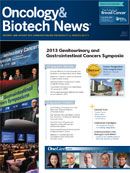Publication
Article
(Molecular) Pathways, Pathways, and More Pathways
Author(s):
The oncology we all learned over the past three decades will soon be a thing of the past, making way for therapy decisions based on what molecular switches should be turned on and off, and of equal importance, in what sequence.
Andrew L. Pecora, MD
Editor-in-Chief
Oncology & Biotech News
Chief Innovations Officer, Professor, and Vice President of Cancer Services John Theurer Cancer Center at Hackensack University Medical Center
It will soon be a requirement that every practicing oncologist and hematologist has readily available the oncology molecular pathway equivalent of the New York City underground subway map to guide them on “which train to take” to get to their patients’ desired destination. The content of the 2013 Gastrointestinal (GI) and Genitourinary (GU) Cancers Symposia further illustrates that the oncology we all learned over the past three decades will soon be a thing of the past, making way for therapy decisions based on what molecular switches should be turned on and off, and of equal importance, in what sequence.
Of note, there is already enough information available to demonstrate that it is foolish, at least for now, to try to memorize the molecular pathways like we all did with anatomy, and then later with the taxonomy of cancer as defined by histopathology. We will be better served to have access to an iteratively updated pathway guide once diagnostic/prognostic tests are validated in regard to prognosis and for therapy selection.
At the 2013 GI Cancers Symposium, a broad array of molecular prowess was on display. In one abstract (380), Hochster and colleagues reported on second-line therapy of KRAS-mutated metastatic colorectal cancer with the MEK inhibitor selumetinib in combination with irinotecan. MET overexpression turns out to be a hallmark of the epithelial-mesenchymal transition phenotype in colorectal cancer (abstract 334). Another abstract (377) reported that stratification of stage II colon cancer appears to be improved using deep amplicon sequencing of cancer genes. Moreover, Kopetz et al showed that genomic classifiers predicted outcome and chemotherapy benefit in colorectal cancer (abstract 378). EGFR-independent activation of another pathway, PI3K in KRAS wild-type colorectal cancer, was shown to possibly confer resistance to cetuximab (abstract 385).
DNA was not the only story at the GI Symposium; RNA appears to be a player in the evolving new oncology molecular pathway road map. Micro- RNA-21 expression in colorectal cancer appears to be a predictor of response to fluoropyrimidine-based adjuvant chemotherapy (abstract 408).
The GI crowd were not the only ones having fun in this evolving arena. An abstract (101) presented at the 2013 GU Cancers Symposium studied the effects of PI3K/AKT/mTOR pathways on androgen receptors as drivers in androgen-independent prostate cancer. Another pathway of emerging interest is Wnt-1 induced signaling protein-2 and its effect on angiogenesis and invasion in prostate cancer (abstract 164). MicroRNA also caught the attention of GU investigators. A particular microRNA signature appears capable of distinguishing early from late biochemical failures in prostate cancer (abstract 194).
It has been an eye-opening journey for those of us who started in this field when we administered drugs without any understanding of how or why they worked, only because by chance they were found to work. My editorial only scratches the surface of what was discussed at these two conferences, never mind the activities of the entire field. One can easily get intimidated by the vastness of all of the possibilities and the foreignness of the new language. At the same time, it is inspiring to know that slowly but surely we are “peeling the onion” to get to the “truth” driving the varied diseases we treat. One can only hope that with the right “map” we can guide an ever-increasing number of our patients to their desired locations.
Note: The 2013 Gastrointestinal and Genitourinary Cancers Symposia abstracts discussed in this column can be accessed at http://bit.ly/ascoabstracts.










